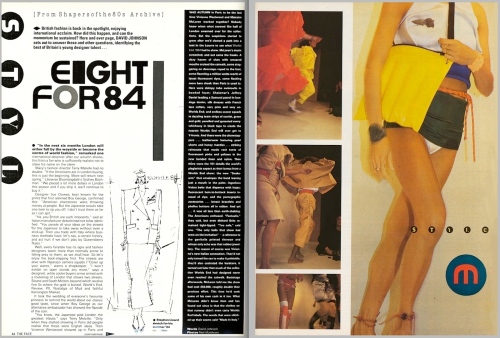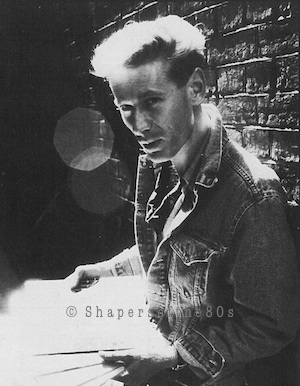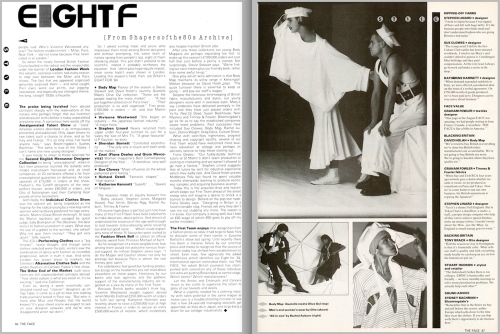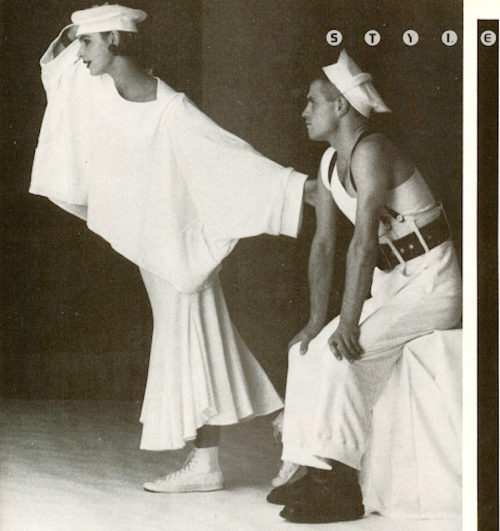➤ Overseas influencers declare eight
hot fashion Brits for 1984
Posted by David Johnson on November 8, 2017
1983 proved a tumultuous year for British youth culture. By December, London’s leading club deejay Jay Strongman declared “This was the year of Go For It”, after 17 new British pop groups lorded it in the US top 40 chart that autumn, while our spirited fashionistas were making waves around the world, with Princess Diana playing ambassador for the classic designers, and Boy George pushing the wilder extremes of street style. Among major features I wrote for The Face was February’s cover story The Making of Club Culture, and in the Evening Standard Posing with a purpose at the Camden Palace, a centre spread on the runaway megaclub hosted by Strange and Egan.
Nightlife was a burgeoning story as black beats took over dancefloors everywhere and Manchester’s tearaway megaclub was the Hacienda, despite the oppressive clean-up being imposed by the city’s infamous Chief Constable. Clubbers from across the nation swarmed in to create a grand coalition of all the cults – “your complete i-D line-up, minus the Worlds End spendthrifts”. In my January report for The Face one inmate bemoaned Hacienda music as “too funk-based” though another, a flat-top lad called Johnny Maher, revealed his secret, despite having launched some new indie rock band minutes earlier. “I schtupp to funk,” he said.
In July The Face published a major piece of reportage, Art on the Run, prompted by numerous friends in fine-art education, and billed it as a “shock report” on the Conservative government’s debilitating squeeze on the art schools. Ironically in the same issue my regular Nightlife column identified the four hottest clubland teams as a Who’s Who in the New London Weekend: “Not since the Swinging Sixties had London nightlife reverberated to such a boom.” These clubs were the unofficial job centres that kept a generation in freelance employment and introduced the verb to vop into the language (derivation: “What are you up to these days?” – “Oh, a Variety Of Projects”). Some of that effort was fuelling the rise of computer games which in the June issue Virgin assured me was “the new pop industry”!
My Nightlife column in The Face’s October issue featured Brighton’s trendiest hotspot (seconds before the very word trendy passed its sell-by outside the Greater London stockade). The Can was presided over by a young Oliver Peyton with Andy Hale as the deejay breaking funk there. Years later Oliver thanked me for this exposure and said he would never have come up to London and started opening restaurants without The Face’s prompt! (One of the few people who have ever thanked me for writing about them! Cheers, Oliver.)
By this fertile year’s end I had FIVE indicative pieces of reportage published in the December issue of The Face including a detailed rundown on the new dance music scene by club deejay Jay Strongman, plus news of the imminent Westwood/ McLaren break-up which I’d scented from body language backstage at their Paris runway show.
The launch of the first London Fashion Week that same October confirmed that British street style was being feted in the international spotlight, yet it begged the question how on earth had this suddenly come about? The feature that follows here set out to answer such questions, by asking decision-makers in the industry to identify the best of Britain’s young designer talent under the headline. . .
➤ Eight for 1984
First published in The Face in December 1983
“IN THE NEXT SIX MONTHS London will either fall by the wayside or become the centre of world fashion,” remarked one international observer after our autumn shows, this from a fan who is sufficiently realistic not to stake his name on the claim.
Macy’s fashion director Terry Melville had no doubts: “If the Americans are in London buying, this is just the beginning. More will return next spring.” Likewise Bloomingdale’s Sydney Bachman: “We placed a lot more dollars in London this season and if you ship it, we’ll continue to buy it.”
Designer Sue Clowes, best known for the prints that first adorned Boy George, confirmed the trend: “American chainstores were throwing money at people. But the Japanese scouts take one item to rip you off. I don’t trust them as far as I can spit.”
“Ha, you British are such innocents,” said an Italian manufacturer determined not to be identified. “You parade all your ideas on the streets for the Japanese to take away without even a stick up. Then you trade with Italy where business methods have, let’s say, a certain history, and act hurt if we don’t play by Queensberry Rules.”
Well, every fairytale has its ogre and fashion designers seem more than normally prone to falling prey to them, as we shall hear. So let’s enjoy the back slapping first. The streets are alive with Niparazzi camera squads (“Cover up your wares,” warns one shopkeeper; “I won’t exhibit on open stands any more,” says a designer), while cooler buyers arrive armed with a route-map of London that shows two streets, Sloane and South Molton, beyond which revolve five Xs where the gold is buried: World’s End, Review, PX, Nostalgia of Mud and faithful Kensington Market.
It took the wedding of everyone’s favourite princess to remind the world about our classic good taste, since when Boy George as our alternative ambassador has shown the flipside of the coin.
“You know, the Japanese paid London the greatest tribute,” says Terry Melville. “Only when they started showing in Paris did people realise that these were English ideas. Then Vivienne Westwood showed up in Paris and people said, Who’s Vivienne Westwood anyway? The fashion establishment – Milan, Paris, New York – did not know because they never called in at London.”
As for Italy and France, “it’s so long since
I’ve found anyone new,” says Bloomingdale’s
Sydney Bachman. “The same is true of the States:
I can’t name one new young designer.”
So when the newly formed British Fashion Council pulled in the radical and the respectable under the banner of London Fashion Week this autumn, overseas visitors had every reason to stop over between the Milan and Paris shows. The fact that we appeared organised genuinely surprised them – and what caught their eyes were our prints, our jogging sweatwear, and especially our strongest theme, the long, straight 1930s silhouette.
The praise being lavished from abroad contrasts sharply with the reservations of the natives who perhaps forget that our invention and obsession with clothes is today unparalleled anywhere else. A consensus here wrote off the Amalgamated Talent Show as “staid” whereas visitors described it as immaculately presented and publicised. Only Japan allows its raw talent such a chance to show, and as for Italy and France, “it’s so long since I’ve found anyone new,” says Bloomingdale’s Sydney Bachman. “The same is true of the States: I can’t name one new young designer.”
It was trendy to sneer at those selected for the Second English Menswear Designer Collection for being “unexceptional”, when in fact their presence stunned the dullards who inhabit mainstream menswear and, as small companies, all 23 exhibitors offered a far from unexceptional guarantee on deliveries. All took upwards of £15,000 in orders at the show. Hudson’s, the Cardiff designers of the near perfect trouser, wrote £60,000 in orders, and Olto of Nottingham said their Camping Gear proved all time bestsellers.
Admittedly the Individual Clothes Show was the tackiest yet, being torpedoed as the flagship for the radical young by a new big name sponsor who tactlessly plastered his logo everywhere: Martini (great British thinking!). At least the Martini top brass got savaged by guest judge, Sally Brampton of The Observer, the best recruit to fashion journalism in years. What was the use of a goblet to the winners, she asked? Why not give them money? “They got very upset,” Sally reports.
The ICA’s Performing Clothes was a “big mistake”, some thought, and though some clothes selected were indeed the pits, visitors saw the combination of dance with fashion as incredibly progressive, which in truth it was. And while London has grown blasé to markets like Chelsea’s Alternative Clothes Sale and the wilder theatrics of Camden Palace’s first show, The Other End of the Market, such occasions are still unprecedented concepts abroad. “Your street culture is what you excel at, it’s so exciting,” said one Californian visitor.
Even so, during a week essentially constructed round our “classier” designers up on Top Table, it came as a jolt to hear one leading trade journalist based in Paris say: “But who is there after Muir and Rhodes that the world knows? It’s your street scene we expect to see on your designer catwalks and we’re very disappointed when we don’t.”
So I asked visiting trade and press who impresses them most among British designers and without prompting, the same First Team sprang from people’s lips, eight of them streaking ahead. This poll didn’t pretend to be scientific, indeed it probably reinforces the equation that talent plus hype equals impact, since some hadn’t even shown in London. Leading this season’s field, then, are:
BRITAIN’S EIGHT FOR ’84…
1 – Body Map Flavour of the season is Stevie Stewart and David Holah’s raunchy Querelle Meets Olive Oyl collection. “These are the people leading the mass market”… “A real put together collection on Paris lines”… “Their production is so well organised.” First prize, £100,000 in orders – oh, and that Martini goblet.
2 – Vivienne Westwood “She began an industry – the Japanese fashion industry”… “A major force”.
3 – Stephen Linard Newly returned from Japan under four-year contract to Jun for a salary the size of Mrs T’s (so he says). “A great favourite,” said J P Gaultier, no less.
4 – Sheridan Barnett “Controlled eccentricity”… “The only one in touch with both ends of the market”.
5 – Zwei (Fiona Dealey and Gioia Marcovicz) Woman magazine’s Best Contemporary Designer of the Year… “A stand out, very well produced”.
6 – Sue Clowes “Major influence on the whole patterned print feeling”.
7 – Richard Ostell “Fantastic shapes”… “High drama”.
8 – Katharine Hamnett “Superb”… “Queen of fatigues”.
The rest of the First Team made an equally buoyant mix … Betty Jackson, Stephen Jones, Margaret Howell, Paul Smith, Wendy Rigg, Rachel Auburn, Timney & Fowler.
Of course hype plays a part but just note how many of this First Fifteen have bold statements to make about sex, about politics. And almost all understand the essence of the age well enough to nod towards status dressing while resisting out-and-out good taste … Which could explain why NONE of these 15 favourites were invited to the Fashion Week Ball to collect an official industry award from Princess Michael of Kent.
As for recognition of a more tangible kind, few among them would not welcome serious financial support. As milliner Stephen Jones says: “I do the Mugler and Gaultier shows not only for prestige but because Paris is where the real money gets spent.”
Fat order-books feel good but funding production brings on the headaches you can read about elsewhere on these pages. Hesitancy by our banks and loan agencies and the pathetic support of the manufacturing industry are regarded as a joke by many of the First Team.
Because British banks wouldn’t think big, Vivienne Westwood sought support abroad when Worlds End had £250,000 worth of orders to fulfil last spring. Katharine Hamnett was recently driven to raise a £200,000 loan at high interest in France in order to secure an extra £500,000 worth of income, which incidentally also helped maintain British jobs.
After only three collections our young BodyMappers are perhaps expanding too fast: to make up this season’s £100,000 orders will cost half that sum before a penny is earned. Not surprisingly, Stevie Stewart says: “We’re finding our own means plus our friendly bank, rather than some awful tie up.”
One ploy which wins admiration is that Body Map maintains its utility range in Kensington Market because as David Holah says: “The quick turnover there is essential to keep us going – and pay our staff’s wages.”
Despite the notorious time keeping of British fabric manufacturers and dyers, our young designers score well in overseas eyes. Macy’s says Londoners have delivered promptly in the past and it has just placed orders with Ya Ya, Red Or Dead, Susan Backhouse, New Masters and Timney & Fowler. Bloomingdale’s goes so far as to say the established companies cause more problems. Its past successes have included Sue Clowes, BodyMap, Rachel Auburn, Donna Weight, Greg Davis, Culture Shock.
Until recently there has been a massive failure
by our uncritical press and media to recognise that
the source of fashion today has shifted
from establishment to street
What with cash-flow nightmares, progress chasing and copyright rip-offs, several of our First Team would have welcomed more business education at college and perhaps an advisory service to help those starting out.
Fiona Dealey, who graduated with a first-class degree in fashion: “Our fuddy duddy technical tutors at St Martin’s didn’t teach production or costing or marketing and we weren’t allowed to go near a factory.” Stephen Linard, another first from St Martin’s, suggests that all tutors be sent for industrial experience which they sadly lack. And while David Holah praises Middlesex Poly, he found he spent valuable months afterwards learning to produce economic samples and acquiring business acumen.
Today this is the acquired drive and realism which keeps our First Team ahead of the street sheep who still imagine a desire to shock is a licence to design. Behind all the pop star hype, Fiona Dealey says: “Designing in Britain is a hard miserable slog. Friends ask why they don’t see me out clubbing any more. The reason is I’m broke. Our company is doing well, but I take an £80 wage, of which £60 goes to pay off my earlier mistakes.”
The First Team enjoys little recognition from a British fashion press so slow it had to go to New York to discover some of their names in Susanne Bartsch’s show last spring. Until recently there has been a massive failure by our uncritical press and media to recognise that the source of fashion today has shifted from establishment to street. Even now, few appreciate the added worldliness which identifies our Eight for ’84. International opinion nominated them, NOT The Face. Yet which British journalist has championed with conviction any of these individualists who are putting Britain back at centre stage. Which stores? Which manufacturers?
Let the Amies and Emanuels and Conrans return to the crofts to supervise the return to glory of our tweeds and wools. What is urgently needed for a clothing industry with sales potential in the same league as motor cars is a trouble-shooting minister to see that a few 24-year-old managing directors get appointed, as they do in Japan, and to go bang a drum for our cottage industrialists.
RIPPING OFF YARNS: THE DOWNSIDE
OF BEING BRITISH
KATHARINE HAMNETT, designer
“When demand expanded suddenly in Italy, we were offered a production deal on the basis of a verbal agreement. On £750,000 worth of goods produced, we’ve been paid zero. Designers can be very naive about business.”
STEPHEN LINARD, designer
“I went to Japan because I was ripped off here and left with huge debts. It’s the business people who think small and don’t understand fashion who are giving Britain a bad name.”
SUE CLOWES, designer
“The tramp motif I did for the first Culture Club outfits has been imitated worldwide. I tried to sue Macy’s and couldn’t afford to pursue it. I challenged Miss Selfridge and they paid compensation. At the very least I always go berserk and make a scene in the shop.”
DAVID HOLAH, BodyMap
“We’ve tried to buy British in everything we’ve done but British fabric manufacturers are so unreliable. We’re not going to buy British any more. We’re going to Sweden where they have quality too.”
GRAHAM FOWLER, Timney & Fowler fabrics
“When Sue and I left the RCA four years ago nobody gave a damn whether we sank or swam, so we produced as consultants in Paris and Tokyo. Now we’ve come home to run our own business, the British mainstream is copying the Japanese!”
STEPHEN LINARD, designer
“Yes it’s a shame I left England. But in Tokyo I have a chauffeur, a studio, a staff, a proper design company who help all they can to achieve special finishes and make up unique fabrics. I needn’t worry about the How, just the What. In England so much energy goes to waste.”
TONY BRACK, Olto designer
“Half the reason we stay in Nottingham is that it’s financially safer. What sells our stuff is quality and with everything made locally we can keep an eye on how the buttons are put on.”
STUART HUDSON, stylist and retailer
“The Individual Clothes Show is too collegey. EMDC is businesslike and friendly – we have monthly meetings to solve mutual production problems. We actually help each other.”
GRAHAM FOWLER, textiles designer
“One page in the August FACE was amazing: we had people writing in from France, Canada, everywhere. THE FACE is like a bible in America.”
SYDNEY BACHMAN, Bloomingdale’s
“Remember that in the States we buy and sell before the season, unlike Europe which sells closer to the time they wear the clothes. If you can ship early there’s opportunity to do business here.”
A WOW AND A WOBBLE BEFORE
WORLDS END FELL APART
Worlds End’s Hypnos collection shown in Paris on 17 October 1983 was named after the Greek god of sleep though it proved as active and restless on the runway as the machinations developing backstage… As reported in the December issue of The Face:
◼ WAS AUTUMN IN PARIS to be the last time Vivienne Westwood and Malcolm McLaren worked together? Nobody knew when what seemed like half of London swanned over for the collections. But the suspicions started to grow after we’d clawed a path into a tent in the Louvre to see what the Worlds End Hypnos collection promised for 1984. McLaren’s music screeched and out came the freaks.
A dozy harem of sluts with smeared mouths cruised the catwalk, some staggering on doorsteps roped to the foot, some flaunting a million watts worth of latest fluorescent dyes, some flashing more bare cheek than Paris is used to. Here were skimpy tube swimsuits in bonded foam; Shalamar’s Jeffrey Daniel leading a Samurai patrol in bondage denim; silk dresses with French lace collars, very prim and very un Worlds End; and endless soccer squads in dazzling team strips of scarlet, green and gold, panelled and gusseted every whichway in black tape to create the nearest Worlds End will ever get to Y fronts.
And there were the showstoppers … leatherwear featuring pearl shorts and honey mantles … striking raincoats that made vast tents of fluorescent pinks and yellows in the new bonded linen and nylon. Then there were the 101 details international plagiarists expect as their bonus from a Worlds End show: the new “Snakearm” that envelopes the hand leaving just a mouth in the palm; ingenious Velcro belts that dispense with loops; fluorescent hem to buttock inserts instead of zips; and the pornographic accessories … breast bracelets and phallus buttons all in rubber. And yet… it was all less than earth shaking.
The Americans enthused. “Fantastic,” they said, but even diehard Brits remained tight lipped. “Too safe,” said one. “The only balls that show had were on the invitation” – a reference to the genitalia printed thereon and whose only echo was that rubber jewellery.
The reason of course was Vivienne’s new Italian connection [later revealed to be Elio Fiorucci]. They’d not only tamed the sex to make it palatable, they’d also castrated the hardcore. It turned out later that much of the collection Worlds End had designed never even reached the catwalk. Backstage afterwards, McLaren told me the show had cost £50,000, roughly double their previous effort. This time he’d sunk some of his own cash in it too. What McLaren didn’t know then and has found out since is that the clothes on that runway didn’t even carry Worlds End labels. The words that were stitched up their seams said “Made In Italy.”
☐☐☐
THEN THE FRENCH PACKAGED THE
NEW SWINGING LONDON
◼ THREE MONTHS LATER, in March 1984, a monumental wrap-up of my peripatetic journey following London’s subcultural evolution had been translated into immaculate French (with help from my little glossary of crucial words such as the dole and vopping), in a whole 272-page issue of the sociologist’s bible Autrement.
Titled Londres: 100 ans de retard, 10 ans d’avance, this was a guide to decoding the new society of the Brits. My piece considering the forces fuelling London’s new clubbing underground was one of 20 essays putting us under the microscope, of which four others came from British contributors: Anne Corbett, Vivien Goldman, Chris Salewicz and Jon Savage. As it was, from my desk at the Evening Standard, I’d already become a tourist information service for journalists and TV crews pouring into London from abroad and who expected a tour of the trendiest nightspots at their expense. By the end of ’84 I was ready to call it a day.

















Pingback: Jess Abigail
Pingback: Gary Scott